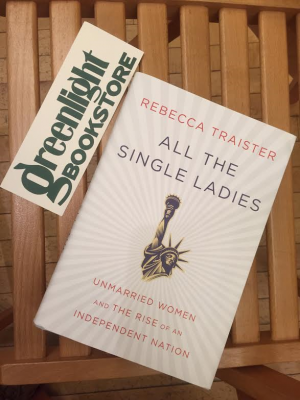(You Don’t Have To) Put a Ring On It
March 19, 2016

“I always hated it when my heroines got married,” Rebecca Traister begins in her thorough new book, “All the Single Ladies: Unmarried Women and the Rise of an Independent Nation,” which chronicles the tales of women who choose to delay, or forego, marriage. Here, Traister laments the disappointing endings that marriages of adventurous, independent characters like Jane Eyre, Anne Shirley and Jo March, bring to their stories. If this sounds like the beginning to a 300-page argument for why women should not get married, it is anything but. Rather, this book traces the historical moments that have led to our present era, in which marriage, same-sex or otherwise, is a choice that women are free to make—but that they are also free to not.
This book is not about condemning marriage, (Traister is, after all, happily married), but instead shedding light on a rising demographic of single, working women—of various economic and racial backgrounds—who are no longer content to be defined by their partnerships. “The revolution is in the expansion of options, the lifting of the imperative that for centuries hustled nearly all (non-enslaved) women,” Traister writes. “Single life is not prescription, but its opposite: liberation.”
“All the Single Ladies” pays homage to past women who fought for the marital freedom today’s women may now enjoy. If “traditional” marriage—a man, the breadwinner, marries a woman, the homemaker—is no longer compulsory, then who has paved the way for this reality? Traister’s research cites many famed women who chose to remain single: Florence Nightingale, Susan B. Anthony, Emily Dickinson, etc.. But what is more noteworthy is the group of women who have not been given their due credit for their part in freeing gender roles in marriage: the underprivileged women who for years have rejected marriage, not because they were necessarily taking a stand against it, but because it was not an economically feasible option.
Out of economic need, lower-class women were working women, not homemakers. Marriage was not a profitable, or perhaps even probable, option. “The nation’s history has included many iterations of the privileged white co-option of black, and often poor, habits and behaviors, which, when performed by white populations, have drawn different kinds of attention,” Traister writes. “[W]hen, in the mid-sixties, white women busted out of their domestic sarcophagi and marched back into workforces in which poor and black women had never stopped toiling … that was when the revolution of Second Wave feminism was upon us.” Privileged women were able to shed their aprons in favor of wages—a key factor in the shift of marital practices—because the underprivileged had set that precedent.
Traister’s extensive footnotes and careful organization make “All the Single Ladies” an excellent resource for anyone interested in the changing institution of marriage in our society. This book is predominantly about women choosing to delay or reject marriage to men, however, and therefore provides a very limited discussion of single queer women, or the marriages that queer women may eventually choose to form. Traister does link the legalization of gay marriage’s ability to “[reframe] the power structure of the entire institution, disabling the gendered mechanism by which it historically exerted its oppressive power” with the overall rejection of a one-size-fits-all model for marriage, reminding us, again, that this story is about far more than successful career women turning down marriage proposals. This is a far larger story of citizens who have been burned by the institution of marriage, and who seek a new approach to a once set-in-stone path.
Beyond sharing stories of single women from various walks of life, “All the Single Ladies” cites data from censuses, studies and surveys that provide a solid foundation for the agenda Traister promotes: that an increase in single women is not a bad thing. Countering warnings that “marital decline drives up the rates of poverty and welfare dependence” that are presented by “conservative lawmakers,” Traister debunks several myths about marriage, including that married people are happier than unmarried people (women in bad marriages report being unhappier than their single counterparts), and that marriage will place women in better financial standing (only if both parties’ incomes outweigh their expenses, which, of course, is not always the case).
Ultimately, this is a book that, above all else, demonstrates that single women are not a dangerous, modern-day phenomenon, but rather a significant portion of society, and society’s history, who should be greater accounted for in legislative settings. Traister concludes the book with an appendix that calls for policies including subsidized day care, paid family leave and greater equal pay protections to support the “swelling numbers of unmarried American women.” As we observe Women’s History Month, and the countless women who have contributed intellectually, economically, politically and spiritually to our society, this book directs our focus to the less-told history of the unmarried woman, and the place she forges in today’s society.









